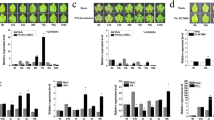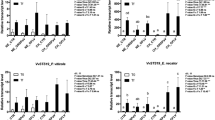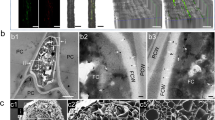Abstract
ALTHOUGH phytoalexins1,2 have long been inferred to be important in the defence of plants against fungal infection1,2, there are few reports showing that they provide resistance to infection. Several plants, including grapevine, synthesize the stilbene-type phytoalexin resveratrol3–7 when attacked by pathogens. Stilbenes with fungicidal potential are formed in several unrelated plant species, such as peanut (Arachis hypogaea), grapevine (Vitis vinifera) and pine (Pinus sylvestris)3,5,11–15. Stilbene biosynthesis only specifically requires the presence of stilbene synthase6,9. Furthermore, the precursor molecules for the formation of hydroxy-stilbenes are malonyl-CoA and p-coumaroyl-CoA, both present in plants9. To investigate the potential of stilbene biosynthetic genes in a strategy of engineering pathogen resistance, we isolated stilbene synthase genes from grapevine, where they are expressed at a high level, and transferred them into tobacco10. We report here that regenerated tobacco plants containing these genes are more resistant to infection by Botrytis cinerea. This is, to our knowledge, the first report of increased disease resistance in transgenic plants based on an additional foreign phytoalexin.
This is a preview of subscription content, access via your institution
Access options
Subscribe to this journal
Receive 51 print issues and online access
$199.00 per year
only $3.90 per issue
Buy this article
- Purchase on Springer Link
- Instant access to full article PDF
Prices may be subject to local taxes which are calculated during checkout
Similar content being viewed by others

References
Ingham, J. Bot. Rev. 38, 343–424 (1972).
Ebel, J. A. Rev. Phytopath. 24, 235–264 (1986).
Gorham, J. Prog. Phytochem. 6, 203–252 (1980).
Ingham, J. Phytochemistry 15, 1791–1793 (1976).
Pont, V. & Pezet, R. J. Phytopath. 130, 1–8 (1990).
Schöppner, A. & Kindl, H. FEBS Lett. 108, 345–352 (1979).
Schröder, G., Brown, J. W. S. & Schröder, J. Eur. J. Biochem. 172, 161–169 (1988).
Melchior, F. & Kindl, H. Arch. Biochem. Biophys. 288, 552–557 (1991).
Hain, R., Bieseler, B., Kindl, H., Schröder, G. & Stöcker, R. Pl. molec. Biol. 15, 325–336 (1990).
Hain, R. et al. Molec. Gen Genet 199, 161–168 (1985).
Stein, U. & Blaich, R. Vitis 24, 75–87 (1985).
Langcake, P. Physiol. Pl. Path. 9, 77–86 (1976).
Langcake, P. & Pryce, R. J. Experientia 33, 151–152 (1977).
Langcake, P. & Pryce, R. J. Phytochemistry 16, 1193–1196 (1977).
Dercks, W. & Creasy, L. L. Physiol. molec. Pl. Path. 34, 189–202 (1989).
Bedbrook, J. Pl. molec. Biol. Newslett. 2, 24 (1981).
Frischauf, A. M., Lehrach, H., Poustka, A. & Murray, N. J. molec. Biol. 170, 827–842 (1983).
Cuypers, B., Schmelzer, E. & Hahlbrock, K. Molec. Pl.-Microbe Interact 1, 157–160 (1988).
Schmelzer, E., Krüger-Lebus, S. & Hahlbrock, K. Pl. Cell 1, 993–1001 (1989).
Tegtmeier, K. J., VanEtten, H. D. Phytopathology 72, 608–612 (1982).
Schäfer, W., Straney, E., Cluffetti, L., VanEtten, H. D. & Yoder, O. C. Science 246, 247–249 (1989).
Linsmaier, E. M. & Skoog, F. Physiol. Pl. 18, 100–127 (1965).
Author information
Authors and Affiliations
Rights and permissions
About this article
Cite this article
Hain, R., Reif, HJ., Krause, E. et al. Disease resistance results from foreign phytoalexin expression in a novel plant. Nature 361, 153–156 (1993). https://doi.org/10.1038/361153a0
Received:
Accepted:
Issue Date:
DOI: https://doi.org/10.1038/361153a0
This article is cited by
-
Overexpressing 4-coumaroyl-CoA ligase and stilbene synthase fusion genes in red raspberry plants leads to resveratrol accumulation and improved resistance against Botrytis cinerea
Journal of Plant Biochemistry and Biotechnology (2023)
-
Grapevine woody tissues accumulate stilbenoids following bud burst
Planta (2023)
-
Tools for engineering resistance against pathogens in plants
Journal of Plant Biochemistry and Biotechnology (2022)
-
Transcriptional and proteomic insights into phytotoxic activity of interspecific potato hybrids with low glycoalkaloid contents
BMC Plant Biology (2021)
-
VqMYB154 promotes polygene expression and enhances resistance to pathogens in Chinese wild grapevine
Horticulture Research (2021)
Comments
By submitting a comment you agree to abide by our Terms and Community Guidelines. If you find something abusive or that does not comply with our terms or guidelines please flag it as inappropriate.


